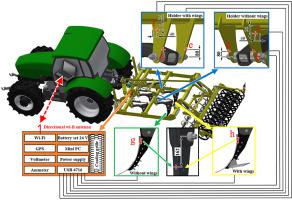Biosystems Engineering ( IF 4.4 ) Pub Date : 2021-07-08 , DOI: 10.1016/j.biosystemseng.2021.06.012 Adam Kešner 1 , Rostislav Chotěborský 1 , Miloslav Linda 2 , Monika Hromasová 2 , Egidijus Katinas 2 , Hadi Sutanto 3

|
Soil tillage machinery must be highly reliable during its operation. For a limited time following harvest, tillage machines must perform a significant amount of work, and any downtime has a significant negative impact on farm economics. For this reason, manufacturers of agricultural machinery aim to design machines that are both reliable and inexpensive. The development of technologies, especially electronics, has led to completely new possibilities for the design and optimisation of agricultural machinery. During work, a tillage machine may not only be loaded by its own weight, but also by the interaction of any tools interacting with the soil that transmit loads to itsframe. To analyse loads a numerical model of tillage machine was compiled. The stresses acting on the chisel shank during tillage were simulated using a numerical model. The frame of the agricultural machine was also simulated with particular emphasis on the locations where the stresses could be measured. Strain gauges were attached at the same locations in a real-life model, and predicted stress values verified experimentally. A discrete element method (DEM) model was used to create and optimise a comprehensive soil model, and its results were used in a finite element method (FEM) model for a transient analysis. The results from the experimental stress measurements and simulation data from the model showed good agreement. Therefore, the procedures of this study can therefore be used for the design and optimisation of tillage machinery.
中文翻译:

用离散元和有限元方法模拟并通过实验验证的带有凿子柄的土壤耕作机框架部分的应力分布
土壤耕作机械在运行过程中必须高度可靠。在收获后的有限时间内,耕作机必须执行大量工作,任何停机时间都会对农场经济产生重大负面影响。出于这个原因,农业机械制造商的目标是设计既可靠又便宜的机器。技术的发展,尤其是电子技术的发展,为农业机械的设计和优化带来了全新的可能性。在工作期间,耕作机不仅可以通过其自身的重量来加载,还可以通过与土壤相互作用的任何工具的相互作用来加载,这些工具将载荷传递到其框架。为了分析载荷,编制了耕作机的数值模型。耕作过程中作用在凿柄上的应力使用数值模型进行模拟。还模拟了农业机械的框架,特别强调了可以测量应力的位置。应变计安装在真实模型中的相同位置,并通过实验验证了预测的应力值。离散元法 (DEM) 模型用于创建和优化综合土壤模型,其结果用于有限元法 (FEM) 模型进行瞬态分析。来自模型的实验应力测量和模拟数据的结果显示出良好的一致性。因此,本研究的程序可用于耕作机械的设计和优化。应变计安装在真实模型中的相同位置,并通过实验验证了预测的应力值。离散元法 (DEM) 模型用于创建和优化综合土壤模型,其结果用于有限元法 (FEM) 模型进行瞬态分析。来自模型的实验应力测量和模拟数据的结果显示出良好的一致性。因此,本研究的程序可用于耕作机械的设计和优化。应变计安装在真实模型中的相同位置,并通过实验验证了预测的应力值。离散元法 (DEM) 模型用于创建和优化综合土壤模型,其结果用于有限元法 (FEM) 模型进行瞬态分析。来自模型的实验应力测量和模拟数据的结果显示出良好的一致性。因此,本研究的程序可用于耕作机械的设计和优化。来自模型的实验应力测量和模拟数据的结果显示出良好的一致性。因此,本研究的程序可用于耕作机械的设计和优化。来自模型的实验应力测量和模拟数据的结果显示出良好的一致性。因此,本研究的程序可用于耕作机械的设计和优化。









































 京公网安备 11010802027423号
京公网安备 11010802027423号